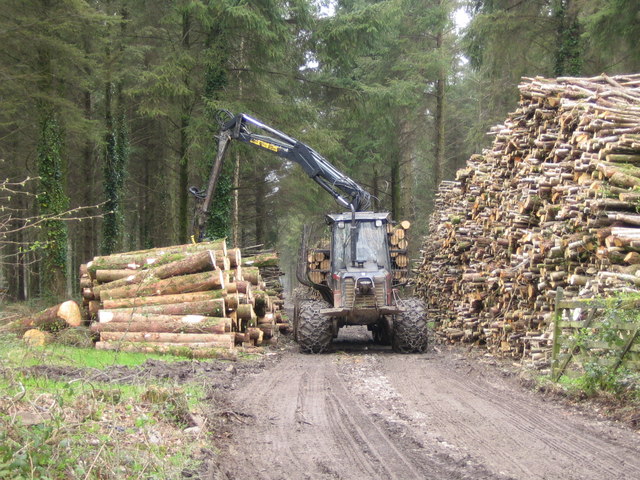Skid Trails, Logging Roads and Landings

Description
Forestry operations require roads for access, skid trails to remove the cut timber, and areas to collect the cut logs (landings) prior to loading and removal by trucks. Chapter 132, The Forest Cutting Practices Act, requires the following BMPs to minimize impacts from skid trails, roads, and landings.
Massachusetts Requirements and Recommendations
Skid Trails
Water bars in skid trails are required at the following spacing. These shallow depressions in the road surface divert collected water before it can erode the surface of the trail or road.
| ROAD GRADE (%) | APPROXIMATE DISTANCE NEEDED BETWEEN WATER BARS(FEET) |
| 1 | 400 |
| 2 | 245 |
| 5 | 125 |
| 10 | 78 |
| 15 | 58 |
| 20 | 47 |
| 25 | 40 |
| 30 | 35 |
| 35 | 32 |
| 40 | 29 |
Do not operate skidders on slopes greater than 60%, unless special permission is given by the Service Forester in the approved Forest Cutting Plan.
Do not operate a machine in a wetland unless the ground is dry, frozen, or otherwise stable enough to support it. Identify the location of wetland and stream crossings on the ground with flagging or paint, as well as on the map with the Forest Cutting Plan.
No machinery is allowed to operate in a certified vernal pool at any time of the year. A 50-foot filter strip must surround each certified vernal pool.
No logging equipment may operate in the filter strip except:
- to reduce environmental damage shown to be necessary in a statement in an approved Forest Cutting Plan,
- at an approved stream crossing,
- on a pre-existing logging road, or
- in filter strips greater than 50 feet in width, beyond 50 feet from the water body.
All principal skid roads will be stabilized whenever they are left inactive for one month or more, or whenever the Service Forester determines such work is necessary.
Truck Roads
Adequate drainage ditches, culverts, and water bars will be provided, and runoff will be led into filter strips or hay bale impoundments to remove sediment.
Access roads from a landing to a highway must be graveled or mulched to prevent mud from tracking onto the highway. Alternatively, they must not be used during wet weather or mud must be removed immediately from the public highway.
When a culvert is used, the Forest Cutting Plan must state its diameter, based on the following culvert-sizing table:
| AREA ABOVE PIPE (ACRES) | PIPE DIAMETER ( INCHES) |
| TYPE I | TYPE II |
| 1 | 8 | 8 |
| 5 | 12 | 12 |
| 10 | 15 | 18 |
| 15 | 18 | 24 |
| 20 | 24 | 24 |
| 25 | 24 | 24 |
| 30 | 24 | 30 |
| 35 | 30 | 30 |
| 40 | 30 | 30 |
| 45 | 30 | 30 |
| 50 | 30 | 36 |
| 75 | 36 | 36 |
| 100 | 48 | 48 |
| 150 | 48 | 48 |
| 200 | 60 | 60 |
| 250 | 60 | 60 |
Type I terrain is forested and rolling, with slopes between 5 and 10%. Type II terrain is forested and hilly, with slopes between 10 and 30%. Culvert diameters are based on the 25-year storm.
Landings
All unnatural debris such as cans, papers, discarded tires, metal parts, and other junk must be removed. Woody debris will be placed neatly to improve appearance and promote rapid decay.
Soil will be stabilized and if necessary seeded to grass at the end of the operation.
References
Kittredge Jr., D. B. and M. Parker. 1995. Massachusetts Forestry Best Management Practices Manual.
MADEP and USEPA-Region 1, Water Division, Water Quality Section. MADEP. 2001. The Massachusetts Unpaved Roads BMP Manual. Project 98-06/319. USDA. 2002. Massachusetts Forest Resource Fact Sheet. Northeastern Area - State and Private Forestry.
USEPA. 1993. Polluted Runoff (Nonpoint Source Pollution): Guidance Specifying Management Measures for Sources of Nonpoint Pollution in Coastal Waters. EPA-840-B-93-001c. Office of Wetlands, Oceans, and Water- sheds.
http://www.epa.gov/owow/nps/MMGI
USEPA. 1995. Polluted Runoff (Nonpoint Source Pollution): Planning Considerations for Roads, Highways, and Bridges. EPA-841-F-95-008b. Office of Water.